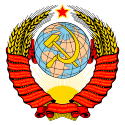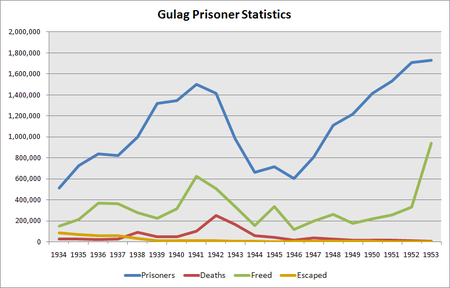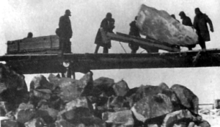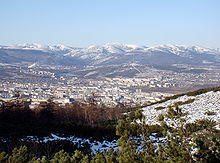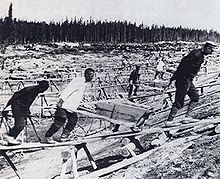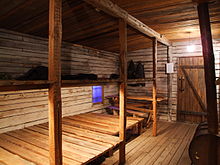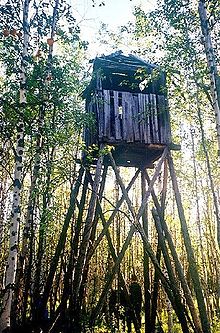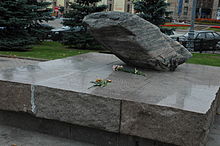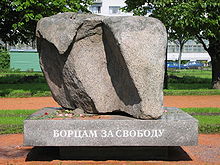- Gulag
-
For other uses, see Gulag (disambiguation).
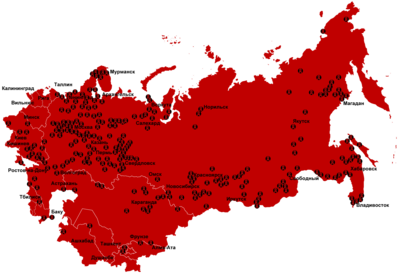 The integrated map of the Gulag camps, which existed from 1923 to 1961, based on data from the Human Rights Society «Memorial»
The integrated map of the Gulag camps, which existed from 1923 to 1961, based on data from the Human Rights Society «Memorial»
The Gulag (Russian: ГУЛаг, tr. GULag, IPA: [ɡʊˈlak] (
 listen)) was the government agency that administered the main[1] Soviet forced labor camp systems. While the camps housed a wide range of convicts, from petty criminals to political prisoners, large numbers were convicted by simplified procedures, such as NKVD troikas and other instruments of extrajudicial punishment, and the Gulag is recognized as a major instrument of political repression in the Soviet Union.
listen)) was the government agency that administered the main[1] Soviet forced labor camp systems. While the camps housed a wide range of convicts, from petty criminals to political prisoners, large numbers were convicted by simplified procedures, such as NKVD troikas and other instruments of extrajudicial punishment, and the Gulag is recognized as a major instrument of political repression in the Soviet Union.GULag is the acronym for Chief Administration of Corrective Labor Camps and Colonies (Russian: Гла́вное управле́ние исправи́тельно-трудовы́х лагере́й и коло́ний, tr. Glavnoye upravlyeniye ispravityel'no-trudovih lagyeryey i koloniy) of the NKVD. It was officially created on April 25, 1930 and dissolved on January 13, 1960.[2] Eventually, by metonymy, the usage of "the Gulag" began generally denoting the entire penal labor system in the USSR.
Aleksandr Solzhenitsyn, winner of the 1970 Nobel Prize in Literature, introduced the term to the Western world with the 1973 publication of his The Gulag Archipelago. The book likened the scattered camps to "a chain of islands" and described the Gulag as a system where people were worked to death.[3][neutrality is disputed] Some scholars[quantify] concur with this view,[4][5] whereas others[quantify] argue that the Gulag was neither as large nor as deadly as it is often presented,[6] and it did not have death camps,[7] although during some periods of its history, mortality was high in the labor camps.[3]
On March 1940, there were 53 separate camps and 423 labor colonies in the USSR.[6] Today's major industrial cities of the Russian Arctic, such as Norilsk, Vorkuta, and Magadan, were originally camps built by prisoners and run by ex-prisoners.[8]
Contents
Brief history
14 million people passed through the Gulag "labour camps" from 1929 to 1953, with a further 6 to 7 million being deported and exiled to remote areas of the USSR, plus 4-5 millions passed through "labour colonies", which meant to confine the prisoners serving short (less than 3 years) terms.[11] The total population of the camps varied from 510,307 (in 1934) to 1,727,970 (in 1953).[6] According to a 1993 study of archival Soviet data, a total of 1,053,829 people died in the Gulag from 1934 to 1953.[6] These estimates exclude those who died shortly after their release but whose death resulted from the harsh treatment in the camps;[12] such deaths happened frequently.[13] The studies that take into account these deaths put the death toll for this same time period at 1,258,537, with an estimated 1.6 million casualties from 1929 to 1953.[14]
Most Gulag inmates were not political prisoners, although the political prisoner population was always significant.[15] People could be imprisoned in a Gulag camp for crimes such as petty theft and joking about government officials.[16][17] About half of the political prisoners were sent to Gulag prison camps without trial; official data suggest that there were more than 2.6 million imprisonment sentences in cases investigated by the secret police, 1921-1953.[18] The Gulag was radically reduced in size following Stalin’s death in 1953.
In 1960 the Soviet-wide MVD (oversight organization for the Gulag) was shut down in favor of individual republic MVD (Ministry of Interior). The nationwide centralized command detention facilities (Gulag) temporarily ceased to function.[19] Political prisoners also continued to be held in the Soviet Union during the Gorbachev era.[20]
Modern usage and other terminology
Although Gulag was originally the name of a government agency, the acronym acquired the qualities of a common noun, denoting: the Soviet system of prison-based, unfree labor — including specific labor, punishment, criminal, political, and transit camps for men, women, and children.
Even more broadly, "Gulag" has come to mean the Soviet repressive system itself, the set of procedures that prisoners once called the "meat-grinder": the arrests, the interrogations, the transport in unheated cattle cars, the forced labor, the destruction of families, the years spent in exile, the early and unnecessary deaths.[21]
Other authors, mostly in the West, use gulag as denoting all the prisons and internment camps in Soviet history (1917–1991) with the plural gulags. The term's contemporary usage is notably unrelated to the USSR, such as in the expression “North Korea's Gulag”[22] for camps operational still today.[23]
The word Gulag was not often used in Russian — either officially or colloquially; the predominant terms were the camps (лагеря, lagerya) and the zone (зона, zona), usually singular — for the labor camp system and for the individual camps. The official term, "corrective labor camp", was suggested for official politburo of the Communist Party of the Soviet Union use in the session of July 27, 1929.
History
Repression in the Soviet Union General Political repression • Economic repression • Ideological repression Political repression Red Terror • Collectivization • Great Purge • Population transfer • Gulag • Holodomor • Mass killings under Communist regimes • Political abuse of psychiatry Ideological repression
Religion • Suppressed research • Censorship • Censorship of images Background
From 1920s to 1950s, the leaders of the Communist Party and Soviet state considered repressiveness not only as a way to provide the conditions for normal functioning of the state system, but also to preserve and strengthen positions of their social base, presented by working class, in society. From social class perspectives, the Gulag is an offspring of the working class which became a leading class of society after the October Revolution. The Gulag was invented to isolate class-alien, socially dangerous, disruptive, suspicious, and other disloyal elements (real and imaginary ones) whose deeds and thoughts were not contributing to the strengthening of the “dictatorship of the proletariat.” After having appeared as a tool and place for isolating counterrevolutionary and criminal elements to protect and strengthen the “dictatorship of the proletariat,” the Gulag, because of its principle of “correction by forced labor”, quickly became, in fact, an independent branch of the national economy secured on a cheap labor force presented by prisoners. Without this “industry”, it has actually become impossible to solve many tasks of industrialization in eastern and northern regions. Hence it is followed by one more important reason for the constancy of the repressive policy, namely, the state's interest in unremitting rates of receiving the cheap labor force that was forcibly used mainly in the extreme conditions of the east and north.[24] Thus, the Gulag possessed two functions, the first one was punitive, and the second one was economic.[25]
According to Anne Applebaum, "In 1906, only about 6000 katorga convicts were serving sentences; in 1916, on the eve of the Revolution, there were only 28,600."[3][26] After the Russian Revolution of 1917 the Russian penal system was taken over by the Bolsheviks. From 1918, camp-type detention facilities were set up, as a reformed analogy of the earlier system of penal labor (katorgas), operated in Siberia in Imperial Russia. The two main types were "Vechecka Special-purpose Camps" (особые лагеря ВЧК, osobiye lagerya VChK) and forced labor camps (лагеря принудительных работ, lagerya prinuditel'nikh rabot). They were installed for various categories of people deemed dangerous for the state: for common criminals, for prisoners of the Russian Civil War, for officials accused of corruption, sabotage and embezzlement, various political enemies and dissidents, as well as former aristocrats, businessmen and large land owners. These camps, however, were not on the same scale as those in the Stalin era. In 1928 there were 30,000 prisoners in camps, and the authorities were opposed to compelling them to work. In 1927 the official in charge of prison administration wrote that: "The exploitation of prison labor, the system of squeezing ‘golden sweat’ from them, the organization of production in places of confinement, which while profitable from a commercial point of view is fundamentally lacking in corrective significance – these are entirely inadmissible in Soviet places of confinement.”[27]
The legal base and the guidance for the creation of the system of "corrective labor camps" (Russian: исправительно-трудовые лагеря, Ispravitel'no-trudovye lagerya), the backbone of what is commonly referred to as the "Gulag", was a secret decree of Sovnarkom of July 11, 1929, about the use of penal labor that duplicated the corresponding appendix to the minutes of Politburo meeting of June 27, 1929.
Creation of "Gulag" and its expansion under Stalin
As an all-Union institution and a main administration with the OGPU (the Soviet secret police), the Gulag was officially established on April 25, 1930 as the "ULAG" by the OGPU order 130/63 in accordance with the Sovnarkom order 22 p. 248 dated April 7, 1930, and was renamed into Gulag in November.[2]
In the early 1930s a drastic tightening of Soviet penal policy caused a significant growth of the prison camp population. During the period of the Great Purge (1937–38) mass arrests caused another increase in inmate numbers. During these years hundreds of thousands of individuals were arrested and sentenced to long prison terms on the grounds of one of the multiple passages of the notorious Article 58 of the Criminal Codes of the Union republics, which defined punishment for various forms of "counterrevolutionary activities." Under NKVD Order № 00447 tens of thousands of Gulag inmates who were accused of "continuing anti-Soviet activity in imprisonment" were executed in 1937-38.
The hypothesis that economic considerations were responsible for mass arrests during the period of Stalinism has been refuted on the grounds of former Soviet archives that have become accessible since the 1990s, although some archival sources also tend to support an economic hypothesis.[28][29] In any case the development of the camp system followed economic lines. The growth of the camp system coincided with the peak of the Soviet industrialization campaign. Most of the camps established to accommodate the masses of incoming prisoners were assigned distinct economic tasks. These included the exploitation of natural resources and the colonization of remote areas as well as the realization of enormous infrastructural facilities and industrial construction projects.
In 1931–32 archives indicate the Gulag had approximately 200,000 prisoners in the camps; in 1935 — approximately 800,000 in camps and 300,000 in colonies (annual averages).[30]
Between 1934 and 1941, the number of prisoners with higher education increased more than eight times, and the number of prisoners with high education increased five times. It resulted in their increased share in the overall composition of the camp prisoners. Among the camp prisoners, the number and share of the intelligentsia was growing at the quickest pace. Distrust, hostility, and even hatred for the intelligentsia is a common characteristic of the communist leaders. After having laid hold of unlimited power, they, as practice has shown, were simply unable to resist the temptation to mock the intelligentsia. The Stalin version of mocking the intelligentsia was the referral of its part to the Gulag on the basis of far-fetched or fabricated charges. For unrepressed part of the intelligentsia, the mockery was prepared in the form of “ideological dressing down”, leading and guiding instructions “from above” on how to think, do, worship the “leaders”, etc.[24]
During World War II
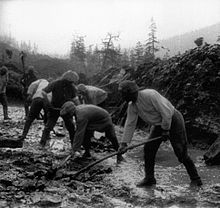 Road construction by inmates of the Dalstroy (part of the 'Road of Bones' from Magadan to Jakutsk).
Road construction by inmates of the Dalstroy (part of the 'Road of Bones' from Magadan to Jakutsk).
On the eve of World War II, Soviet archives indicate a combined camp and colony population upwards of 1.6 million in 1939, according to V. P. Kozlov.[30] Anne Applebaum and Steven Rosefielde estimate that 1.2 to 1.5 million people were in Gulag system's prison camps and colonies when the war started.[31][32]
After the German invasion of Poland that marked the start of WWII, the Soviet Union invaded and annexed eastern parts of the Second Polish Republic. In 1940 the Soviet Union occupied Estonia, Latvia, Lithuania, Bessarabia (now the Republic of Moldova) and Bukovina. According to some estimates, hundreds of thousands of Polish citizens[33][34] and inhabitants of the other annexed lands, regardless of their ethnic origin, were arrested and sent to the gulag camps. However, according to the official data, the total number of sentences for political and antistate (espionage, terrorism) crimes in USSR in 1939-41 was 211,106.[18]
Approximately 300,000 Polish prisoners of war were captured by the USSR during and after the 'Polish Defensive War'.[35] Almost all of the captured officers and a large number of ordinary soldiers were then murdered (see Katyn massacre) or sent to GULag[36] Of the 10,000-12,000 Poles sent to Kolyma in 1940-1941, most POWs, only 583 men survived, released in 1942 to join the Polish Armed Forces in the East.[37] Out of Anders' 80,000 evacuees from Soviet Union gathered in Great Britain only 310 volunteered to return to Soviet-controlled Poland in 1947.[38]
During the war, Gulag populations declined sharply due to a steep rise in mortality in 1942–43. In the winter of 1941 a quarter of the Gulag's population died of starvation.[39] 516,841 prisoners died in prison camps in 1941-43.[40][41]
In 1943, the term katorga works (каторжные работы) was reintroduced. They were initially intended for Nazi collaborators, but then other categories of political prisoners (for example, members of deported peoples who fled from exile) were also sentenced to "katorga works". Prisoners sentenced to "katorga works" were sent to Gulag prison camps with the most harsh regime and many of them perished.[41]
After World War II
After World War II the number of inmates in prison camps and colonies, again, rose sharply, reaching approximately 2.5 million people by the early 1950s (about 1.7 million of whom were in camps).
When the war ended in May 1945, as many as two million former Russian citizens were forcefully repatriated into the USSR.[42] On 11 February 1945, at the conclusion of the Yalta Conference, the United States and United Kingdom signed a Repatriation Agreement with the Soviet Union.[43] One interpretation of this agreement resulted in the forcible repatriation of all Soviets. British and U.S. civilian authorities ordered their military forces in Europe to deport to the Soviet Union up to two million former residents of the Soviet Union, including persons who had left the Russian Empire and established different citizenship years before. The forced repatriation operations took place from 1945-1947.[44]
Often, one finds statements that Soviet POWs on their return to the Soviet Union were often treated as traitors (see Order No. 270).[45][46][47] According to some sources, over 1.5 million surviving Red Army soldiers imprisoned by the Germans were sent to the Gulag.[48][49][50] However, that is a confusion with two other types of camps. During and after World War II, freed PoWs went to special "filtration" camps. Of these, by 1944, more than 90 percent were cleared, and about 8 percent were arrested or condemned to penal battalions. In 1944, they were sent directly to reserve military formations to be cleared by the NKVD. Further, in 1945, about 100 filtration camps were set for repatriated Ostarbeiter, PoWs, and other displaced persons, which processed more than 4,000,000 people. By 1946, the major part of the population of these camps were cleared by NKVD and either sent home or conscripted (see table for details).[51] 226,127 out of 1,539,475 POWs were transferred to the NKVD, i.e. the Gulag.[51][52]
Results of the checks and the filtration of the repatriants (by 1 March 1946)[51] Category Total % Civilian % POWs % Released and sent home (this figure included those who died in custody) 2,427,906 57.81 2,146,126 80.68 281,780 18.31 Conscripted 801,152 19.08 141,962 5.34 659,190 42.82 Sent to labour battalions of the Ministry of Defence 608,095 14.48 263,647 9.91 344,448 22.37 Sent to NKVD as spetskontingent(i.e. sent to GULAG) 272,867 6.50 46,740 1.76 226,127 14.69 Were waiting for transportation and worked for Soviet military units abroad 89,468 2.13 61,538 2.31 27,930 1,81 Totally: 4,199,488 2,660,013 1,539,475 After Nazi Germany's defeat, ten NKVD-run "special camps" subordinate to the Gulag were set up in the Soviet Occupation Zone of post-war Germany. These "special camps" were former Stalags, prisons, or Nazi concentration camps such as Sachsenhausen (special camp number 7) and Buchenwald (special camp number 2). According to German government estimates "65,000 people died in those Soviet-run camps or in transportation to them."[53] According to German researchers, Sachsenhausen, where 12,500 Soviet era victims have been uncovered, should be seen as an integral part of the Gulag system.[54]
For years after World War II, a significant[citation needed] minority[vague] of the inmates were Ukrainians, Belarusians, Lithuanians, Latvians and Estonians from lands newly incorporated into the Soviet Union, as well as Finns, Poles, Volga Germans, Romanians and others.[citation needed] POWs, in contrast, were kept in a separate camp system (see POW labor in the Soviet Union), which was managed by GUPVI, a separate main administration with the NKVD/MVD.[citation needed]
Yet the major reason for the post-war increase in the number of prisoners was the tightening of legislation on property offences in summer 1947 (at this time there was a famine in some parts of the Soviet Union, claiming about 1 million lives), which resulted in hundreds of thousands of convictions to lengthy prison terms, sometimes on the basis of cases of petty theft or embezzlement. At the beginning of 1953 the total number of prisoners in prison camps was more than 2.4 million of which more than 465 thousand were political prisoners.[41]
The state continued to maintain the extensive camp system for a while after Stalin's death in March 1953, although the period saw the grip of the camp authorities weaken and a number of conflicts and uprisings occur (see Bitch Wars; Kengir uprising; Vorkuta uprising).
The amnesty in March 1953 was limited to non-political prisoners and for political prisoners sentenced to not more than 5 years, therefore mostly those convicted for common crimes were then freed. The release of political prisoners started in 1954 and became widespread, and also coupled with mass rehabilitations, after Nikita Khrushchev's denunciation of Stalinism in his Secret Speech at the 20th Congress of the CPSU in February 1956.
By the end of the 1950s, virtually all "corrective labor camps" were dissolved. Colonies, however, continued to exist. Officially the Gulag was liquidated by the MVD order No 020 of 25 January 1960.[2]
(See also Foreign forced labor in the Soviet Union)
Conditions
Living and working conditions in the camps varied significantly across time and place, depending, among other things, on the impact of broader events (World War II, countrywide famines and shortages, waves of terror, sudden influx or release of large numbers of prisoners). However, to one degree or another, the large majority of prisoners at most times faced meagre food rations, inadequate clothing, overcrowding, poorly insulated housing, poor hygiene, and inadequate health care. Most prisoners were compelled to perform harsh physical labor.[55] In most periods and economic branches, the degree of mechanization of work processes was significantly lower than in the civilian industry: tools were often primitive and machinery, if existent, short in supply. Officially established work hours were in most periods longer and days off were fewer than for civilian workers. Often official work time regulations were extended by local camp administrators.
Andrei Vyshinsky, procurator of the Soviet Union, wrote a memorandum to NKVD chief Nikolai Yezhov in 1938 which stated:
Among the prisoners there are some so ragged and liceridden that they pose a sanitary danger to the rest. These prisoners have deteriorated to the point of losing any resemblance to human beings. Lacking food . . . they collect orts [refuse] and, according to some prisoners, eat rats and dogs. [56]
Shack from Gulag - reconstruction in Museum of the Occupation of Latvia
In general, the central administrative bodies showed a discernible interest in maintaining the labor force of prisoners in a condition allowing the fulfillment of construction and production plans handed down from above. Besides a wide array of punishments for prisoners refusing to work (which, in practice, were sometimes applied to prisoners that were too enfeebled to meet production quota), they instituted a number of positive incentives intended to boost productivity. These included monetary bonuses (since the early 1930s) and wage payments (from 1950 onwards), cuts of individual sentences, general early-release schemes for norm fulfillment and overfulfillment (until 1939, again in selected camps from 1946 onwards), preferential treatment, and privileges for the most productive workers (shock workers or Stakhanovites in Soviet parlance).[57]
A distinctive incentive scheme that included both coercive and motivational elements and was applied universally in all camps consisted in standardized "nourishment scales": the size of the inmates’ ration depended on the percentage of the work quota delivered. Naftaly Frenkel is credited for the introduction of this policy. While it was effective in compelling many prisoners to work harder, for many a prisoner it had the adverse effect, accelerating the exhaustion and sometimes causing the death of persons unable to fulfill high production quota.
Immediately after the German attack on the Soviet Union in June 1941 the conditions in camps worsened drastically: quotas were increased, rations cut, and medical supplies came close to none, all of which led to a sharp increase in mortality. The situation slowly improved in the final period and after the end of the war.
Considering the overall conditions and their influence on inmates, it is important to distinguish three major strata of Gulag inmates:
- "kulaks", osadniks, "ukazniks" (people sentenced for violation of various ukases, such as Law of Spikelets, decree about work discipline, etc.), occasional violators of criminal law
- dedicated criminals: "thieves in law"
- people sentenced for various political and religious reasons
Mortality in Gulag camps in 1934-40 was 4-6 times higher than average in Russia. The estimated total number of those who died in imprisonment in 1930-1953 is 1.76 million, about half of which occurred between 1941-1943 following the German invasion.[58][59] If prisoner deaths from labor colonies and special settlements are included, the death toll rises to 2,749,163, although the historian who compiled this estimate (J. Otto Pohl) stresses that it is incomplete, and doesn't cover all prisoner categories for every year.[13][60] Other scholars have stressed that internal discrepancies in archival material suggests that the NKVD Gulag data are seriously incomplete.[14] Adam Jones wrote:
It was these Siberian camps, devoted either to gold-mining or timber harvesting, that inflicted the greatest toll in the Gulag system. Such camps “can only be described as extermination centres,” according to Leo Kuper. The camp network that came to symbolize the horrors of the Gulag was centered on the Kolyma gold-fields, where “outside work for prisoners was compulsory until the temperature reached −50C and the death rate among miners in the goldfields was estimated at about 30 per cent per annum. [61]
Social conditions
The convicts in such camps were actively involved in all kinds of labor with one of them being logging (lesopoval). The working territory of logging presented by itself a square and was surrounded by forest clearing. Thus, all attempts to exit or escape from it were well observed from the four towers set at each of its corners.
When investigating the shooting of these "escaping" prisoners, the position of the dead body was usually the only factor considered[citation needed]. That the body would lay with its feet to the camp and its head away from it was considered sufficient evidence of an escape attempt. As a result, it was common practice for the guards to simply adjust the position of the body after killing a "runner" to ensure that the killing would be declared justified.[citation needed] There is some evidence that money rewards were given to any guards who shot an escaping prisoner, but the official rules (as seen below) state guards were fined for escaping prisoners.[citation needed]
Locals who captured a runaway were given rewards.[62] Its also said that Gulags in colder areas, were less keen on "escaping" prisoners as they would die anyhow for the cold and severe winters. Prisoners who did escape without getting shot were often found dead miles away from the camp.
Geography
In the early days of Gulag, the locations for the camps were chosen primarily for the isolated conditions involved. Remote monasteries in particular were frequently reused as sites for new camps. The site on the Solovetsky Islands in the White Sea is one of the earliest and also most noteworthy, taking root soon after the Revolution in 1918.[3] The colloquial name for the islands, "Solovki", entered the vernacular as a synonym for the labor camp in general. It was presented to the world as an example of the new Soviet method for "re-education of class enemies" and reintegrating them through labor into Soviet society. Initially the inmates, largely Russian intelligentsia, enjoyed relative freedom (within the natural confinement of the islands). Local newspapers and magazines were published and even some scientific research was carried out (e.g., a local botanical garden was maintained, but unfortunately later lost completely). Eventually Solovki turned into an ordinary Gulag camp; in fact some historians maintain that it was a pilot camp of this type. See Solovki for more detail. In 1929 Maxim Gorky visited the camp and published an apology for it.
With the new emphasis on Gulag as the means of concentrating cheap labor, new camps were then constructed throughout the Soviet sphere of influence, wherever the economic task at hand dictated their existence (or was designed specifically to avail itself of them, such as the White Sea-Baltic Canal or the Baikal Amur Mainline), including facilities in big cities — parts of the famous Moscow Metro and the Moscow State University new campus were built by forced labor. Many more projects during the rapid industrialization of the 1930s, war-time and post-war periods were fulfilled on the backs of convicts, and the activity of Gulag camps spanned a wide cross-section of Soviet industry.
The majority of Gulag camps were positioned in extremely remote areas of north-eastern Siberia (the best known clusters are Sevvostlag (The North-East Camps) along Kolyma river and Norillag near Norilsk) and in the south-eastern parts of the Soviet Union, mainly in the steppes of Kazakhstan (Luglag, Steplag, Peschanlag). A very precise map was made by the Memorial Foundation.[63] These were vast and sparsely inhabited regions with no roads (in fact, the construction of the roads themselves was assigned to the inmates of specialized railroad camps) or sources of food, but rich in minerals and other natural resources (such as timber). However, camps were generally spread throughout the entire Soviet Union, including the European parts of Russia, Belarus, and Ukraine. There were also several camps located outside of the Soviet Union, in Czechoslovakia, Hungary, Poland, and Mongolia, which were under the direct control of the Gulag.
Not all camps were fortified; in fact some in Siberia were marked only by posts. Escape was deterred by the harsh elements, as well as tracking dogs that were assigned to each camp. While during the 1920s and 1930s native tribes often aided escapees, many of the tribes were also victimized by escaped thieves. Tantalized by large rewards as well, they began aiding authorities in the capture of Gulag inmates. Camp guards were also given stern incentive to keep their inmates in line at all costs; if a prisoner escaped under a guard's watch, the guard would often be stripped of his uniform and become a Gulag inmate himself[citation needed]. Further, if an escaping prisoner was shot, guards could be fined amounts that were often equivalent to one or two weeks wages[citation needed].
In some cases, teams of inmates were dropped off in new territory with a limited supply of resources and left to set up a new camp or die. Sometimes it took several waves of colonists before any one group survived to establish the camp[citation needed].
The area along the Indigirka river was known as the Gulag inside the Gulag. In 1926, the Oimiakon (Оймякон) village in this region registered the record low temperature of −71.2 °C (−96 °F).
Under the supervision of Lavrenty Beria who headed both NKVD and the Soviet Atom bomb program until his demise in 1953, thousands of zeks were used to mine uranium ore and prepare test facilities on Novaya Zemlya, Vaygach Island, Semipalatinsk, among other sites.
Throughout the history of the Soviet Union, at least 476 separate camp administrations existed.[64][65] The Russian researcher Galina Ivanovna stated that, "to date, Russian historians have discovered and described 476 camps that existed at different times on the territory of the USSR. It is well known that practically every one of them had several branches, many of which were quite large. In addition to the large numbers of camps, there were no less than 2,000 colonies. It would be virtually impossible to reflect the entire mass of Gulag facilities on a map that would also account for the various times of their existence."[66] Since many of these existed only for short periods of time, the number of camp administrations at any given point was lower. It peaked in the early 1950s, when there were more than a hundred different camp administrations across the Soviet Union. Most camp administrations oversaw not just one, but several single camp units, some as many as dozens or even hundreds.[67] The infamous complexes were those at Kolyma, Norilsk, and Vorkuta, all in arctic or subarctic regions. However, prisoner mortality in Norilsk in most periods was actually lower than across the camp system as a whole.[68]
Special institutions
- Special camps or zones for children (Gulag jargon: "малолетки", maloletki, underaged), for disabled (in Spassk), and for mothers ("мамки", mamki) with babies.
- Camps for "wives of traitors of Motherland" — there was a special category of repression: "Traitor of Motherland Family Member" (ЧСИР, член семьи изменника Родины: ChSIR, Chlyen sem'i izmennika Rodini).
- Sharashka (шарашка, the goofing-off place) were in fact secret research laboratories, where the arrested and convicted scientists, some of them prominent, were anonymously developing new technologies, and also conducting basic research.
Historiography
Archival documents
Statistical reports made by the OGPU-NKVD-MGB-MVD between the 1930s and 1950s are kept in the State Archive of the Russian Federation formerly called Central State Archive of the October Revolution (CSAOR). These documents were highly classified and inaccessible. Amid glasnost and democratization in the late 1980s, Viktor Zemskov and other Russian researchers managed to gain access to the documents and published the highly classified statistical data collected by the OGPU-NKVD-MGB-MVD and related to the number of the Gulag prisoners, special settlers, etc. In 1995, Zemskov wrote that foreign scientists have begun to be admitted to the restricted-access collection of these documents in the State Archive of the Russian Federation since 1992.[69] However, the only one historian, namely Zemskov, was admitted to these archives, and later the archives were again “closed”, according to Leonid Lopatnikov.[70]
While considering the issue of reliability of the primary data provided by corrective labor institutions, it is necessary to take into account the following two circumstances. On the one hand, their administration was not interested to understate the number of prisoners in its reports, because it would have automatically led to a decrease in the food supply plan for camps, prisons, and corrective labor colonies. The decrement in food would have been accompanied by an increase in mortality that would have led to wrecking of the vast production program of the Gulag. On the other hand, overstatement of data of the number of prisoners also did not comply with departmental interests, because it was fraught with the same (i.e., impossible) increase in production tasks set by planning bodies. In those days, people were highly responsible for non-fulfilment of plan. It seems that a resultant of these objective departmental interests was a sufficient degree of reliability of the reports.[71]
Between 1990 and 1992, the first precise statistical data on the Gulag based on the Gulag archives were published by Viktor Zemskov.[72] These had been generally accepted by leading Western scholars,[11][12] despite the fact that a number of inconsistencies were found in this statistics.[73] It is also necessary to note that not all conclusion drawn by Zemskov based on his data had been generally accepted. Thus, Sergei Maksudov noted that although the literary sources, for example the books of Lev Razgon or Aleksandr Solzhenitsyn, did not envisage the total number of the camps very well and markedly exaggerated their size, at the same time, from their experience, they knew something extraordinarily important about the Archipelago, its diabolical anti-human nature. On the other hand, Viktor Zemskov, who published many documents by the NKVD and KGB, is very far from understanding of the Gulag essence and the nature of socio-political processes in the country. Without distinguishing the degree of accuracy and reliability of certain figures, without making a critical analysis of sources, without comparing new data with already known information, Zemskov absolutizes the published materials by presenting them as the ultimate truth. As a result, his attempts to make generalized statements with reference to a particular document, as a rule, do not hold water.[74]
In response, Zemskov wrote that the charge that Zemskov allegedly did not compare new data with already known information could not be called fair. In his words, the trouble with most western writers is that they do not benefit from such comparisons. Zemskov added that when he tried not to overuse the juxtaposition of new information with “old” one, it was only because of a sense of delicacy, not to once again psychologically traumatize the researchers whose works used incorrect figures, as it turned out after the publication of the statistics by the OGPU-NKVD-MGB-MVD.[69]
According to French historian Nicolas Werth, the mountains of the materials of the Gulag archives, which are stored in funds of the State Archive of the Russian Federation and are being constantly exposed during the last fifteen years, represent only a very small part of bureaucratic prose of immense size left over the decades of “creativity” by the dull and reptile organization managing the Gulag. In many cases, local camp archives, which had been stored in sheds, barracks, or other rapidly disintegrating buildings, simply disappeared in the same way as most of the camp buildings did.[75]
In 2004 and 2005, some archival documents were published in the edition Istoriya Stalinskogo Gulaga. Konets 1920-kh — Pervaya Polovina 1950-kh Godov. Sobranie Dokumentov v 7 Tomakh (The History of Stalin’s Gulag. From the Late 1920s to the First Half of the 1950s. Collection of Documents in Seven Volumes) wherein each of its seven volumes covered a particular issue indicated in the title of the volume: the first volume has the title Massovye Repressii v SSSR (Mass Repression in the USSR),[76] the second volume has the title Karatelnaya Sistema. Struktura i Kadry (Punitive System. Structure and Cadres),[77] the third volume has the title Ekonomika Gulaga (Economy of the Gulag),[78] the forth volume has the title Naselenie Gulaga. Chislennost i Usloviya Soderzhaniya (The Population of the Gulag. The Number and Conditions of Confinement),[79] the fifth volume has the title Specpereselentsy v SSSR (Specsettlers in the USSR),[80] the sixth volume has the title Vosstaniya, Bunty i Zabastovki Zaklyuchyonnykh (Uprisings, Riots, and Strikes of Prisoners),[81] the seventh volume has the title Sovetskaya Pepressivno-karatelnaya Politika i Penitentsiarnaya Sistema. Annotirovanniy Ukazatel Del GA RF (Soviet Repressive and Punitive Policy. Annotated Index of Cases of the SA RF).[82] The edition contains the brief introductions by the two “patriarchs of the Gulag science”, Robert Conquest and Aleksandr Solzhenitsyn, and 1431 documents, the overwhelming majority of which were obtained from funds of the State Archive of the Russian Federation.[83]
History of Gulag population estimates
During the decades before the dissolution of the USSR, the debates about the population size of GULAG failed to arrive to generally accepted figures; wide-ranging estimates have been offered,[84] and the bias toward higher or lower side was frequently affected by political views of the particular author.[84] Some of those earlier estimates (both high and low) are shown in the table below.
Outdated historical estimates of the GULAG population size (in chronological order) GULAG population Year the estimate was made for Source Methodology 15 million 1940-42 Mora & Zwiernag(1945)[85] -- 2.3 million December 1937 Timasheff(1948)[86] Calculation of disenfranchised population Up to 3.5 million 1941 Jasny(1951)[87] Analysis of the output of the Soviet enterprises run by NKVD 50 million total number of persons
passed through GULAGSolzhenitsyn(1975)[88] Analysis of various indirect data,
including own experience and testimonies of numerous witnesses16 million 1938 Antonov-Ovseenko(1980)[89] -- 4-5 million 1939 Wheatcroft(1981)[90] Analysis of demographic data.a 10.6 million 1941 Rosefielde(1981)[91] Based on data of Mora & Zwiernak and annual mortality.a 5.5-9.5 million late 1938 Conquest (1991)[92] 1937 Census figures, arrest and deaths
estimates, variety of personal and literary sources.a4-5 million every single year Volkogonov (1990s)[93] a.^ Note: Later numbers from Rosefielde, Wheatcroft and Conquest were revised down by the authors themselves.[11][31] Political reforms in the USSR in late 1980s ("glastnost'") and subsequent dissolution of the USSR had led to release of a large amount of formerly classified archival documents,[94] including new demographic and NKVD data.[12] Analysis of the official GULAG statistics by Western scholars immediately demonstrated that, despite their inconsistency, they do not support previously published higher estimates.[84] Importantly, the released documents made possible to clarify terminology used to describe different categories of forced labour population, because the use of the terms "forced labour", "GULAG", "camps" interchangeably by early researchers led to significant confusion and resulted in significant inconsistencies in the earlier estimates.[84] Archival studies revealed several components of the NKVD penal system in the Stalinist USSR: prisons, labor camps, labor colonies, as well as various "settlements" (exile) and of non-custodial forced labour.[6] Although most of them fit the definition of forced labour, only labour camps, and labour colonies were associated with punitive forced labour in detention.[6] Forced labour camps ("GULAG camps") were hard regime camps, whose inmates were serving more than three-year terms. As a rule, they were situated in remote parts of the USSR, and labour conditions were extremely hard there. They formed a core of the GUALG system. The inmates of "corrective labour colonies" served shorter terms; these colonies were located in less remote parts of the USSR, and they were run by local NKVD administration.[6] Preliminary analysis of the GULAG camps and colonies statistics (see the chart on the right) demonstrated that the population reached the maximum before the WWII, then dropped sharply, partially due to massive releases, partially due to wartime high mortality, and then was gradually increasing until the end of Stalin era, reaching the global maximum in 1953, when the combined population of GULAG camps and labour colonies amounted 1,727,970 and 465,256, accordingly.[6]
The results of these archival studies forced many scholars, including Robert Conquest[11] or Stephen Wheatcroft to reconsider their earlier estimates of the size of the GULAG population, although with some reservations.[11] Although such scholars as Rosefielde or Vishnevsky point at several inconsistencies in archival data,[73] it is generally believed that these data provide more reliable and detailed information that the indirect data and literary sources available for the scholars during the Cold War era.[12] These data allowed scholars to conclude that during the period of 1928–53, about 14 million prisoners passed through the system of GULAG labour camps and 4-5 passed through the labour colonies.[11] Soviet archival figures should be treated with caution.[says who?] Thus, these figures reflect the number of convicted persons, and do not take into account the fact that a significant part of Gulag inmates had been convicted more than one time, so the actual number of convicted is somewhat overstated by these statistics.[12] From other hand, during some periods of Gulag history the official figures of GULAG population reflected the camps' capacity, not the actual amount of inmates, so the actual figures were 15% higher in, e.g. 1946.[11]
Influence
Culture
The Gulag spanned nearly four decades of Soviet and East European history and affected millions of individuals. Its cultural impact was enormous.
The Gulag has become a major influence on contemporary Russian thinking, and an important part of modern Russian folklore. Many songs by the authors-performers known as the bards, most notably Vladimir Vysotsky and Alexander Galich, neither of whom ever served time in the camps, describe life inside the Gulag and glorified the life of "Zeks". Words and phrases which originated in the labor camps became part of the Russian/Soviet vernacular in the 1960s and 1970s.
 Ukrainian prisoner Nikolai Getman who spent the years 1945-1953 in Siberia, records his testimony in pictures rather than words.[95]
Ukrainian prisoner Nikolai Getman who spent the years 1945-1953 in Siberia, records his testimony in pictures rather than words.[95]
The memoirs of Alexander Dolgun, Aleksandr Solzhenitsyn, Varlam Shalamov and Yevgenia Ginzburg, among others, became a symbol of defiance in Soviet society. These writings, particularly those of Solzhenitsyn, harshly chastised the Soviet people for their tolerance and apathy regarding the Gulag, but at the same time provided a testament to the courage and resolve of those who were imprisoned.
Another cultural phenomenon in the Soviet Union linked with the Gulag was the forced migration of many artists and other people of culture to Siberia. This resulted in a Renaissance of sorts in places like Magadan, where, for example, the quality of theatre production was comparable to Moscow's.
Literature
Many eyewitness accounts of Gulag prisoners have been published:
- Varlam Shalamov's Kolyma Tales is a short-story collection, cited by most major works on the Gulag, and widely considered one of the main Soviet accounts.
- Victor Kravchenko wrote "I Chose Freedom" after defecting to the United States in 1944. As a leader of industrial plants he had encountered forced labor camps in various parts of the Soviet Union from 1935 to 1941. He describes a visit to one camp at Kemerovo on river Tom in Siberia. Factories paid a fixed sum to the KGB for every convict they employed.
- Anatoli Granovsky wrote "I Was an NKVD Agent" after defecting to Sweden in 1946 and included his experiences seeing gulag prisoners as a young boy, as well as his experiences as a prisoner himself in 1939. Granovsky's father was sent to the gulag in 1937.
- Julius Margolin's book A Travel to the Land Ze-Ka was finished in 1947, but it was impossible to publish such a book about the Soviet Union at the time, immediately after World War II.
- Gustaw Herling-Grudziński wrote A World Apart, which was translated into English by Andrzej Ciolkosz and published with an introduction by Bertrand Russell in 1951. By describing life in the gulag in a harrowing personal account, it provides an in-depth, original analysis of the nature of the Soviet communist system.
- Aleksandr Solzhenitsyn's book The Gulag Archipelago was not the first literary work about labor camps. His previous book on the subject, "One Day in the Life of Ivan Denisovich", about a typical day of the GULag inmate, was originally published in the most prestigious Soviet monthly, Novy Mir, (New World), in November 1962, but was soon banned and withdrawn from all libraries. It was the first work to demonstrate the Gulag as an instrument of governmental repression against its own citizens on a massive scale. The First Circle, an account of three days in the lives of prisoners in the Marfino sharashka or special prison was submitted for publication to the Soviet authorities shortly after One Day in the Life of Ivan Denisovich but was rejected and later published abroad in 1968.
- János Rózsás, Hungarian writer, often referred to as the Hungarian Solzhenitsyn, wrote a lot of books and articles on the issue of GULag.
- Zoltan Szalkai, Hungarian documentary filmmaker made several films of gulag camps.
- Karlo Štajner, a Croatian communist active in the former Kingdom of Yugoslavia and manager of Comintern Publishing House in Moscow from 1932–39, was arrested one night and taken from his Moscow home under accusation of anti-revolutionary activities. He spent the following 20 years in camps from Solovki to Norilsk. After USSR–Yugoslavian political normalization he was re-tried and quickly found innocent. He left the Soviet Union with his wife, who had been waiting for him for 20 years, in 1956 and spent the rest of his life in Zagreb, Croatia. He wrote an impressive book entitled 7000 days in Siberia.
- Dancing Under the Red Star by Karl Tobien (ISBN 1-4000-7078-3) tells the story of Margaret Werner, a young athletic girl who moves to Russia right before the start of Stalin's terror. She faces many hardships, as her father is taken away from her and imprisoned. Werner is the only American woman who survived the Gulag to tell about it.
- "Alexander Dolgun's Story: An American in the Gulag." (ISBN 0-394-49497-0), of a member of the US Embassy, and "I Was a Slave in Russia" (ISBN 0-815-95800-5), an American factory owner's son, were two more American citizens interned who wrote of their ordeal. Both were interned due to their American citizenship for about 8 years circa 1946–55.
- Yevgenia Ginzburg wrote two famous books of her remembrances, Journey Into the Whirlwind and Within the Whirlwind.
- Savić Marković Štedimlija, pro-Croatian Montenegrin ideologist and Ustasha regime collaborator. Caught on the run in Austria by the Red Army in 1945, he was sent to the USSR and spent ten years in Gulag. After release, Marković wrote autobiographic account in two volumes titled Ten years in Gulag (Deset godina u Gulagu, Matica crnogorska, Podgorica, Montenegro 2004)
- Sławomir Rawicz's book, The Long Walk is a controversial account of his escape from the gulag during World War II.
Movies and television
- The Way Back
- As Far as My Feet Will Carry Me
- Lost in Siberia
Colonization
Soviet state documents show that the goals of the gulag included colonisation of sparsely-populated remote areas. To this end, the notion of "free settlement" was introduced.
When well-behaved persons had served the majority of their terms, they could be released for "free settlement" (вольное поселение, volnoye poseleniye) outside the confinement of the camp. They were known as "free settlers" (вольнопоселенцы, volnoposelentsy, not to be confused with the term ссыльнопоселенцы,ssyl'noposelentsy, "exile settlers"). In addition, for persons who served full term, but who were denied the free choice of place of residence, it was recommended to assign them for "free settlement" and give them land in the general vicinity of the place of confinement.
The gulag inherited this approach from the katorga system.
Life after term served
Persons who served a term in a camp or in a prison were restricted from taking a wide range of jobs. Concealment of a previous imprisonment was a triable offence. Persons who served terms as "politicals" were nuisances for "First Departments" (Первый Отдел, Pervyj Otdel, outlets of the secret police at all enterprises and institutions), because former "politicals" had to be monitored.
Many people released from camps were restricted from settling in larger cities.
Gulag memorials
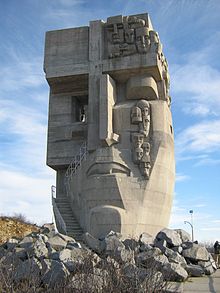 Mask of Sorrow monument in the Russian Far Eastern city of Magadan, in memory of the Gulag prisoners that died in the Dalstroi labor camps
Mask of Sorrow monument in the Russian Far Eastern city of Magadan, in memory of the Gulag prisoners that died in the Dalstroi labor camps
Both Moscow and St. Petersburg have memorials to the victims of the Gulag made of boulders from the Solovki camp — the first prison camp in the Gulag system. Moscow's memorial is on Lubyanka Square, the site of the headquarters of the NKVD. People gather at these memorials every year on the Day of Victims of the Repression (October 30).
Gulag Museum
Moscow has the State Gulag Museum whose director is Anton Antonov-Ovseyenko.[96][97][98]
Notable Gulag prisoners
- Aleksandr Solzhenitsyn
- Karl Steiner
- Vladimir Petrov
- Nikolai Getman
- Nikolay Timofeev-Ressovsky
- Sergey Korolyov
- Varlam Shalamov
- Yusif Vazir Chamanzaminli
- Fr. Walter Ciszek S.J.
See also
- Index of Soviet Union-related articles
- List of Gulag camps
- List of uprisings in the Gulag
- 101st kilometre
- Article 58
- Involuntary settlements in the Soviet Union
- Kengir uprising
- Kolyma
- Mass graves in the Soviet Union
- Memorial
- Nazino affair
- Norilsk uprising, an uprising in Norilsk "Gorlag" (mining camp), 1953
- Persecution of Christians in the Soviet Union
- Population transfer in the Soviet Union
- Punitive psychiatry in the Soviet Union
- Russian Mafia
- Soviet political repression
- Thief in law
- USSR anti-religious campaign (1928–1941)
- Letters from Russian Prisons
- Forced labor camps elsewhere
- Devil's Island (France)
- The Vietnamese Gulag
- Extermination through labor (Nazi Germany)
- Danube-Black Sea Canal (Communist Romania)
- Katorga (Russian Empire)
- Laogai (China)
- Goli Otok (Yugoslavia)
- Yodok (North Korea)
- Camp 22 (North Korea)
References
- ^ Other Soviet penal labor systems not included in GULag were: (a) camps for the prisoners of war captured by the Soviet Union, administered by GUPVI (b) filtration camps created during World War II for temporary detention of Soviet Ostarbeiters and prisoners of war while they were being screened by the security organs in order to "filter out" the black sheep, (c) "special settlements" for internal exiles including "kulaks" and deported ethnic minorities, such as Volga Germans, Poles, Balts, Caucasians, Crimean Tartars, and others. During certain periods of Soviet history, each of them kept millions of people. Many hundreds of thousand were also sentenced to forced labor without imprisonment at their normal place of work (Applebaum, pages 579-580)
- ^ a b c Memorial http://www.memo.ru/history/NKVD/GULAG/r1/r1-4.htm
- ^ a b c d Applebaum, Anne (2003) Gulag: A History. Doubleday. ISBN 0767900561
- ^ Alexander Nikolaevich Yakovlev. A Century of Violence in Soviet Russia. Yale University Press, 2002. ISBN 0-300-08760-8 p. 15
- ^ Steven Rosefielde. Red Holocaust. Routledge, 2009. ISBN 0415777577 pg. 247: "They served as killing fields during much of the Stalin period, and as a vast pool of cheap labor for state projects."
- ^ a b c d e f g h Getty, Rittersporn, Zemskov. Victims of the Soviet Penal System in the Pre-War Years: A First Approach on the Basis of Archival Evidence. The American Historical Review, Vol. 98, No. 4 (Oct., 1993), pp. 1017-1049
- ^ Stephen Wheatcroft. "The Scale and Nature of German and Soviet Repression and Mass Killings, 1930-45", Europe-Asia Studies, Vol. 48, No. 8 (Dec., 1996), pp. 1319-1353
- ^ "Gulag: a History of the Soviet Camps". Arlindo-correia.com. http://www.arlindo-correia.com/041003.html. Retrieved 2009-01-06.
- ^ http://www.etext.org/Politics/Staljin/Staljin/articles/AHR/AHR.html
- ^ http://demoscope.ru/weekly/2007/0313/tema06.php
- ^ a b c d e f g Robert Conquest in "Victims of Stalinism: A Comment." Europe-Asia Studies, Vol. 49, No. 7 (Nov., 1997), pp. 1317-1319 states: "We are all inclined to accept the Zemskov totals (even if not as complete) with their 14 million intake to Gulag 'camps' alone, to which must be added 4-5 million going to Gulag 'colonies', to say nothing of the 3.5 million already in, or sent to, 'labor settlements'. However taken, these are surely 'high' figures."
- ^ a b c d e Ellman, Michael. Soviet Repression Statistics: Some Comments Europe-Asia Studies. Vol 54, No. 7, 2002, 1151-1172
- ^ a b Applebaum, Anne (2003) Gulag: A History. Doubleday. ISBN 0767900561 pg 583: "both archives and memoirs indicate that it was common practice in many camps to release prisoners who were on the point of dying, thereby lowering camp death statistics."
- ^ a b Steven Rosefielde. Red Holocaust. Routledge, 2009. ISBN 0415777577 pg. 67 "...more complete archival data increases camp deaths by 19.4 percent to 1,258,537"; pg 77: "The best archivally based estimate of Gulag excess deaths at present is 1.6 million from 1929 to 1953."
- ^ "Repressions". Publicist.n1.by. http://publicist.n1.by/articles/repressions/repressions_gulag2.html. Retrieved 2009-01-06.
- ^ "What Were Their Crimes?". Gulaghistory.org. http://gulaghistory.org/nps/onlineexhibit/stalin/crimes.php. Retrieved 2009-01-06.
- ^ Uschan, M. Political Leaders. Lucent Books. 2002.
- ^ a b "Repressions". Publicist.n1.by. http://publicist.n1.by/articles/repressions/repressions_organy1.html. Retrieved 2009-01-06.
- ^ http://penpolit.ru/author-item+M5cd00dd4488.html
- ^ News Release: Forced labor camp artifacts from Soviet era on display at NWTC[dead link]
- ^ Anne Applebaum. "GULAG: a history". Archived from the original on October 13, 2007. http://web.archive.org/web/20071013124127/http://anneapplebaum.com/gulag/intro.html. Retrieved 2007-12-21.
- ^ "The Hidden Gulag – Exposing North Korea’s Prison Camps". The Committee for Human Rights in North Korea. http://www.hrnk.org/download/The_Hidden_Gulag.pdf. Retrieved 2011-02-08.
- ^ Antony Barnett (2004-02-01). "Revealed: the gas chamber horror of North Korea's gulag". London: Guardian Unlimited. http://www.guardian.co.uk/korea/article/0,2763,1136483,00.html#article_continue. Retrieved 2007-12-21.
- ^ a b Земсков, Виктор (1991). "ГУЛАГ (историко-социологический аспект)". Социологические исследования (№ 6,7). http://scepsis.ru/library/id_937.html. Retrieved 14 August 2011.
- ^ Ellman, Michael (2002). "Soviet Repression Statistics: Some Comments". Europe-Asia Studies 54 (2): 1151–1172. http://sovietinfo.tripod.com/ELM-Repression_Statistics.pdf. Retrieved 14 August 2011.
- ^ "'Gulag': The Other Killing Machine". The New York Times. May 11, 2003.
- ^ D.J. Dallin and B.I. Nicolayesky, Forced Labor in Soviet Russia, London 1948, p. 153.
- ^ See, e.g. Michael Jakobson, Origins of the GULag: The Soviet Prison Camp System 1917–34, Lexington, KY: University Press of Kentucky, 1993, p. 88.
- ^ See, e.g. Galina M. Ivanova, Labor Camp Socialism: The Gulag in the Totalitarian System, Armonk, NY: M.E. Sharpe, 2000, Chapter 2.
- ^ a b Cf, e.g., Istorija stalinskogo Gulaga: konec 1920-kh - pervaia polovina 1950-kh godov; sobranie dokumentov v 7 tomakh, ed. by V. P. Kozlov et al., Moskva: ROSSPEN 2004, vol. 4: Naselenie Gulaga
- ^ a b The Russian economy: from Lenin to Putin. By Steven Rosefielde. http://books.google.com/books?id=L4s1H9v2yOwC&pg=PA95&lpg=PA95&dq=gulag+population&source=bl&ots=1dI_8IlFub&sig=4F1DU0JHZ4YoGjp8ceznXM5Wals&hl=en&ei=odm0Tbn7Jo7EsAOHwdTzCw&sa=X&oi=book_result&ct=result&resnum=7&sqi=2&ved=0CEkQ6AEwBg#v=onepage&q=gulag%20population&f=false.
- ^ Gulag: a history. By Anne Applebaum. http://books.google.com/books?id=8fIfmxAs_T0C&pg=PA446&lpg=PA446&dq=gulag+total+population&source=bl&ots=K8v68ALmEi&sig=PE8I4S5DjCEgyrgF60xC-RMH0Q8&hl=en&ei=H-G0TfnyFIqosQP-m733Cw&sa=X&oi=book_result&ct=result&resnum=1&ved=0CBcQ6AEwADgK#v=onepage&q=gulag%20total%20population&f=false.
- ^ Franciszek Proch, Poland's Way of the Cross, New York 1987 P.146
- ^ Project In Posterum
- ^ Encyklopedia PWN 'KAMPANIA WRZEŚNIOWA 1939', last retrieved on 10 December 2005, Polish language
- ^ (English) Marek Jan Chodakiewicz (2004). Between Nazis and Soviets: Occupation Politics in Poland, 1939-1947. Lexington Books. ISBN 0739104845.
- ^ "Robert Conquest 1978. Kolyma: The Arctic Death Camps. OUP". London: My.telegraph.co.uk. http://my.telegraph.co.uk/beanbean/blog/2008/05/02/a_polish_life_5_starobielsk_and_the_transsiberian_railway. Retrieved 2009-01-06.[dead link]
- ^ "Michael Hope - "Polish deportees in the Soviet Union"". Wajszczuk.v.pl. http://www.wajszczuk.v.pl/english/drzewo/czytelnia/michael_hope.htm. Retrieved 2009-01-06.
- ^ GULAG: a History, Anne Applebaum
- ^ Zemskov, Gulag, Sociologičeskije issledovanija, 1991, No. 6, pp. 14-15.
- ^ a b c "Repressions". Publicist.n1.by. http://publicist.n1.by/articles/repressions/repressions_gulag1.html. Retrieved 2009-01-06.
- ^ Mark Elliott. "The United States and Forced Repatriation of Soviet Citizens, 1944-47," Political Science Quarterly, Vol. 88, No. 2 (June, 1973), pp. 253-275.
- ^ "Repatriation - The Dark Side of World War II". Fff.org. http://www.fff.org/freedom/0895a.asp. Retrieved 2009-01-06.
- ^ "''Forced Repatriation to the Soviet Union: The Secret Betrayal''". Hillsdale.edu. 1939-09-01. http://www.hillsdale.edu/news/imprimis/archive/issue.asp?year=1988&month=12. Retrieved 2009-01-06.
- ^ "''The warlords: Joseph Stalin''". Channel4.com. 1953-03-06. http://www.channel4.com/history/microsites/H/history/t-z/warlords1stalin.html. Retrieved 2009-01-06.
- ^ "Remembrance (Zeithain Memorial Grove)". Stsg.de. 1941-08-16. http://www.stsg.de/main/zeithain/geschichte/gedenken/index_en.php. Retrieved 2009-01-06.[dead link]
- ^ "Soviet Prisoners of War: Forgotten Nazi Victims of World War II". Historynet.com. 1941-09-08. http://www.historynet.com/wars_conflicts/world_war_2/3037296.html. Retrieved 2009-01-06.
- ^ "Sorting Pieces of the Russian Past". Hoover.org. 2002-10-23. http://www.hoover.org/publications/digest/3063246.html. Retrieved 2009-01-06.
- ^ "Patriots ignore greatest brutality". Smh.com.au. 2007-08-13. http://www.smh.com.au/news/opinion/patriots-ignore-greatest-brutality/2007/08/12/1186857342382.html?page=2. Retrieved 2009-01-06.
- ^ "Joseph Stalin killer file". Moreorless.au.com. 2001-05-23. http://www.moreorless.au.com/killers/stalin.html. Retrieved 2009-01-06.
- ^ a b c Земсков В.Н. К вопросу о репатриации советских граждан. 1944-1951 годы // История СССР. 1990. № 4 (Zemskov V.N. On repatriation of Soviet citizens. Istoriya SSSR., 1990, No.4
- ^ (“Военно-исторический журнал” (“Military-Historical Magazine”), 1997, №5. page 32)
- ^ Germans Find Mass Graves at an Ex-Soviet Camp New York Times, September 24, 1992
- ^ Ex-Death Camp Tells Story Of Nazi and Soviet Horrors New York Times, December 17, 2001
- ^ The Gulag Collection: Paintings of Nikolai Getman[dead link]
- ^ Jonathan Brent. Inside the Stalin Archives: Discovering the New Russia. Atlas & Co., 2008 (ISBN 0977743330) pg. 12 Introduction online (PDF file)
- ^ Leonid Borodkin and Simon Ertz 'Forced Labor and the Need for Motivation: Wages and Bonuses in the Stalinist Camp System', Comparative Economic Studies, June 2005, Vol.47, Iss. 2, pp. 418–436.
- ^ "Demographic Losses Due to Repressions", by Anatoly Vishnevsky, Director of the Center for Human Demography and Ecology, Russian Academy of Sciences, (Russian)
- ^ "The History of the GULAG", by Oleg V.Khlevniuk
- ^ Pohl, The Stalinist Penal System, p. 131.
- ^ Adam Jones (2010). "Genocide: A Comprehensive Introduction". Taylor & Francis. p.195. ISBN 0415486181
- ^ "NIKOLAI GETMAN: The Gulag Collection"
- ^ Map of Gulag, made by the Memorial Foundation on: [1].
- ^ "Система исправительно-трудовых лагерей в СССР". Memo.ru. http://www.memo.ru/history/nkvd/gulag/gulag3.htm. Retrieved 2009-01-06.
- ^ Galina Ivanovna, Labor Camp Socialism: The Gulag in the Totalitarian System (London: M.E. Sharpe, 2000) 188. The Riga branch of “Memorial” has been compiling an ever-expanding list of Gulag locations. It has identified more than 400 Gulag camp sites.
- ^ Galina Ivanovna, Labor Camp Socialism: The Gulag in the Totalitarian System (London: M.E. Sharpe, 2000) 188. The Riga branch of “Memorial” has been compiling an ever-expanding list of Gulag locations. It has identified more than 400 Gulag camp sites.
- ^ Anne Applebaum — Inside the Gulag[dead link]
- ^ "Coercion versus Motivation: Forced Labor in Norilsk" (PDF). http://media.hoover.org/documents/0817939423_75.pdf. Retrieved 2009-01-06.
- ^ a b Земсков, Виктор (1995). "К вопросу о масштабах репрессий в СССР". Социологические исследования (№ 9): 118–127. http://scepsis.ru/library/id_957.html. Retrieved 20 August 2011.
- ^ Лопатников, Леонид (2009). "К дискуссиям о статистике "Большого террора"". Вестник Европы (№ 26–27). http://magazines.russ.ru/vestnik/2009/26/ll28.html. Retrieved 20 August 2011.
- ^ Земсков, Виктор (1994). "Политические репрессии в СССР (1917–1990 гг.).". Россия XXI (№ 1–2): 107–124. http://kob.rv.ua/doki-dai/dotu/other/zemskov/zemskov_politrepressii(1917-1990).pdf. Retrieved 17 August 2011.
- ^ Rousso, Henry; Golsan, Richard (2004). Stalinism and nazism: history and memory compared. U of Nebraska Press. pp. 92. ISBN 0803290004. http://books.google.com/books?id=CIt7fMp30sAC&printsec=frontcover#PPA92,M1.
- ^ a b Vishnevsky, Alantoly. Демографические потери от репрессий (The Demographic Loss of Repression), Demoscope Weekly, December 31, 2007, retrieved 13 Apr 2011
- ^ Максудов, Сергей (1995). "О публикациях в журнале "Социс"". Социологические исследования (№ 9): 114–118. http://scepsis.ru/library/id_956.html. Retrieved 17 August 2011.
- ^ Werth, Nicolas (Juni 2007). "Der Gulag im Prisma der Archive. Zugänge, Erkenntnisse, Ergebnisse". Osteuropa 57 (6): 9–30.
- ^ История сталинского Гулага. Конец 1920-х — первая половина 1950-х годов. Собрание документов в 7 томах. Том 1. Москва: Российская политическая энциклопедия. 2004. ISBN 5824306052.
- ^ История сталинского Гулага. Конец 1920-х — первая половина 1950-х годов. Собрание документов в 7 томах. Том 2. Карательная система. Структура и кадры. Москва: Российская политическая энциклопедия. 2004. ISBN 5824306060.
- ^ История сталинского Гулага. Конец 1920-х — первая половина 1950-х годов. Собрание документов в 7 томах. Том 3. Экономика Гулага. Москва: Российская политическая энциклопедия. 2004. ISBN 5824306079.
- ^ История сталинского Гулага. Конец 1920-х — первая половина 1950-х годов. Собрание документов в 7 томах. Том 4. Население Гулага. Численность и условия содержания. Москва: Российская политическая энциклопедия. 2004. ISBN 5824306087.
- ^ История сталинского Гулага. Конец 1920-х — первая половина 1950-х годов. Собрание документов в 7 томах. Том 5. Спецпереселенцы в СССР. Москва: Российская политическая энциклопедия. 2004. ISBN 5824306085.
- ^ История сталинского Гулага. Конец 1920-х — первая половина 1950-х годов. Собрание документов в 7 томах. Том 6. Восстания, бунты и забастовки заключенных. Москва: Российская политическая энциклопедия. 2004. ISBN 5824306109.
- ^ История сталинского Гулага. Конец 1920-х — первая половина 1950-х годов. Собрание документов в 7 томах. Том 7. Советская репрессивно-карательная политика и пенитенциарная система. Аннотированный указатель дел ГА РФ. Москва: Российская политическая энциклопедия. 2005. ISBN 5824306114.
- ^ Полян, Павел (2006). "Новые карты архипелага ГУЛАГ". Неприкосновенный запас (№2 (46)): 277–286. http://magazines.russ.ru/nz/2006/2/po32.html. Retrieved 20 August 2011.
- ^ a b c d Edwin Bacon. Glasnost' and the Gulag: New Information on Soviet Forced Labour around World War II. Soviet Studies, Vol. 44, No. 6 (1992), pp. 1069-1086
- ^ Cited in David Dallin and Boris Nicolaevsky, Forced Labor in Soviet Russia. (New Haven: Yale University Press, 1947), p. 59-62.
- ^ N. S. Timasheff. The Postwar Population of the Soviet Union. American Journal of Sociology, Vol. 54, No. 2 (Sep., 1948), pp. 148-155
- ^ Naum Jasny. Labor and Output in Soviet Concentration Camps. Journal of Political Economy, Vol. 59, No. 5 (Oct., 1951), pp. 405-419
- ^ Solzhenitsyn, A. The Gulag Archipelago Two, Harper and Row, 1975. Estimate was through 1953.
- ^ Anton Antonov-Ovseenko, Portret tirana (New York: Khronika, 1980), p. 387
- ^ S. G. Wheatcroft. On Assessing the Size of Forced Concentration Camp Labour in the Soviet Union, 1929-56. Soviet Studies, Vol. 33, No. 2 (Apr., 1981), pp. 265-295
- ^ Steven Rosefielde. An Assessment of the Sources and Uses of Gulag Forced Labour 1929-56. Soviet Studies, Vol. 33, No. 1 (Jan., 1981), pp. 51-87
- ^ Robert Conquest. Excess Deaths and Camp Numbers: Some Comments. Soviet Studies, Vol. 43, No. 5 (1991), pp. 949-952
- ^ Rappaport, H. Joseph Stalin: A Biographical Companion. ABC-CLIO Greenwood. 1999.
- ^ Andrea Graziosi. The New Soviet Archival Sources. Hypotheses for a Critical Assessment. Cahiers du Monde russe, Vol. 40, No. 1/2, Archives et nouvelles sources de l'histoiresoviétique, une réévaluation / Assessing the New Soviet Archival Sources (Jan. - Jun., 1999),pp. 13-63
- ^ The Gulag Collection: Paintings of the Soviet Penal System by Former Prisoner Nilolau Getman
- ^ Гальперович, Данила (27 June 2010). "Директор Государственного музея ГУЛАГа Антон Владимирович Антонов-Овсеенко". Radio Liberty. http://www.svobodanews.ru/content/transcript/2085640.html. Retrieved 19 August 2011.
- ^ Banerji, Arup (2008). Writing history in the Soviet Union: making the past work. Berghahn Books. pp. 271. ISBN 8187358378. http://books.google.com/books?id=NqJS-H-odnYC&printsec=frontcover#PPA271,M1.
- ^ "About State Gulag Museum". The State Gulag Museum. http://www.gmig.ru/state-gulag-museum/. Retrieved 19 August 2011.
Further reading
- Books
- Anne Applebaum, Gulag: A History, Broadway Books, 2003, hardcover, 720 pp., ISBN 0-7679-0056-1.
- Walter Ciszek, With God in Russia, Ignatius Press, 1997, 433 pp., ISBN 0-8987-0574-6.
- Simon Ertz, Zwangsarbeit im stalinistischen Lagersystem: Eine Untersuchung der Methoden, Strategien und Ziele ihrer Ausnutzung am Beispiel Norilsk, 1935-1953, Duncker & Humblot, 2006, 273 pp., ISBN 9783428118632.
- Orlando Figes, The Whisperers: Private Life in Stalin's Russia, Allen Lane, 2007, hardcover, 740 pp., ISBN 0141013516.
- J. Arch Getty, Oleg V. Naumov, The Road to Terror: Stalin and the Self-Destruction of the Bolsheviks, 1932-1939, Yale University Press, 1999, 635 pp., ISBN 0-300-07772-6.
- Jehanne M. Gheith and Katherine R. Jolluck. Gulag Voices: Oral Histories of Soviet Detention and Exile (Palgrave Studies in Oral History). Palgrave Macmillan, 2010. ISBN 0230610633
- Slawomir Rawicz. "The Long Walk". 1995. ISBN 1558216847
- Paul R. Gregory, Valery Lazarev, eds, The Economics of Forced Labor: The Soviet Gulag, Stanford: Hoover Institution Press, 2003, ISBN 0-8179-3942-3, full text available online at "Hoover Books Online"
- Jan T. Gross (intro) and Nicolas Werth, Cannibal Island: Death in a Siberian Gulag (Human Rights and Crimes against Humanity). Princeton University Press, 2007. 248 pp., ISBN 0691130833.
- Gustaw Herling-Grudzinski, A World Apart: Imprisonment in a Soviet Labor Camp During World War II, Penguin, 1996, 284 pp., ISBN 0-14-025184-7.
- Adam Hochschild, The Unquiet Ghost: Russians Remember Stalin (Boston: Houghton Mifflin, 2003), 304 pp., paperback: ISBN 0-618-25747-0.
- Oleg V. Khlevniuk, The History of the Gulag: From Collectivization to the Great Terror, Yale University Press, 2004, hardcover, 464 pp., ISBN 0-300-09284-9.
- Tomasz Kizny, Gulag: Life and Death Inside the Soviet Concentration Camps 1917-1990, Firefly Books Ltd., 2004, 496 pp., ISBN 1-55297-964-4.
- Istorija stalinskogo Gulaga: konec 1920-kh - pervaia polovina 1950-kh godov; sobranie dokumentov v 7 tomach, ed. by V. P. Kozlov et al., Moskva: ROSSPEN 2004-5, 7 vols. ISBN 5-8243-0604-4
- Jacques Rossi, The Gulag Handbook: An Encyclopedia Dictionary of Soviet Penitentiary Institutions and Terms Related to the Forced Labor Camps, 1989, ISBN 1-55778-024-2.
- Aleksandr Solzhenitsyn
- The Gulag Archipelago, Harper & Row, 660 pp., ISBN 0-06-080332-0.
- The Gulag Archipelago: Two, Harper & Row, 712 pp., ISBN 0-06-080345-2.
- Karl Tobien. Dancing Under the Red Star: The Extraordinary Story of Margaret Werner, the Only American Woman to Survive Stalin's Gulag. WaterBrook Press, 2006. ISBN 1400070783
- Nicolas Werth, "A State Against Its People: Violence, Repression, and Terror in the Soviet Union, in Stephane Courtois et al., eds., The Black Book of Communism: Crimes, Terror, Repression, Harvard University Press, 1999, ISBN 0-674-07608-7, pp. 33–260.
- "The Literature of Stalin's Repressions" in Azerbaijan International, Vol 14:1 (Spring 2006)
- Memoirs
- Ayyub Baghirov (1906-1973), Bitter Days of Kolyma
- Murtuz Sadikhli (1927-1997), Memory of Blood
- Ummugulsum Sadigzade (died 1944), Prison Diary: Tears Are My Only Companions
- Ummugulsum Sadigzade (died 1944), Letters from Prison to her Young Children
- Remembering Stalin - Azerbaijan International 13.4 (Winter 2005)
- Anne Applebaum (foreword) and Paul Hollander (introduction and editor). From the Gulag to the Killing Fields: Personal Accounts of Political Violence and Repression in Communist States. Intercollegiate Studies Institute, 2006. ISBN 1932236783 (from the annotation: "more than forty dramatic personal memoirs of Communist violence and repression from political prisoners across the globe")
- Janusz Bardach, Man Is Wolf to Man: Surviving the Gulag. University of California Press, 1999. ISBN 0520221524
- Alexander Dolgun, Patrick Watson, "Alexander Dolgun's story: An American in the Gulag", NY, Knopf, 1975, 370 pp., ISBN 978-0394494975.
- Eugenia Ginzburg, Journey into the whirlwind, Harvest/HBJ Book, 2002, 432 pp., ISBN 0156027518.
- Eugenia Ginzburg, Within the Whirlwind, Harvest/HBJ Book, 1982, 448 pp., ISBN 0156976498.
- Jerzy Gliksman, Tell the West: An account of his experiences as a slave laborer in the Union of Soviet Socialist Republics, Gresham Press, 358pp. (abridged edition: New York : National Committee for a Free Europe, c 1948, 95pp.)
- Julius Margolin, ПУТЕШЕСТВИЕ В СТРАНУ ЗЭ-КА A Travel to the Land Ze-Ka, full text, according to the original manuscript (book written in 1947-47, first printed in 1952) (Russian)
- Fyodor V. Mochulsky, Gulag Boss: A Soviet Memoir, Oxford University Press, 272 pp., the first memoir from an NKVD employee translated into English
- Tamara Petkevich, Memoir of a Gulag Actress, Northen Illinois University, 2010
- John H. Noble, I Was a Slave in Russia, Broadview, Illinois: Cicero Bible Press, 1961).
- Varlam Shalamov, Kolyma Tales, Penguin Books, 1995, 528 pp., ISBN 0-14-018695-6.
- Danylo Shumuk,
- Life sentence: Memoirs of a Ukrainian political prisoner, Canadian Institute of Ukrainian Study, 1984, 401 pp., ISBN 978-0920862179.
- Za Chidnim Obriyam - (Beyond The Eastern Horizon),Paris, Baltimore: Smoloskyp, 1974, 447 pp.
- Hava Volovich, My Tale is Told: Women's Memoirs of Gulag, by Simeon Vilensky, Indiana University Press, 1999
- Solzhenitsyn's, Shalamov's, Ginzburg's works at Lib.ru (in original Russian)
- Вернон Кресс (alias of Петр Зигмундович Демант) "Зекамерон XX века", autobiographical novel (Russian)
- Бирюков А.М. Колымские истории: очерки. Новосибирск, 2004
- Fiction
- Aleksandr Solzhenitsyn
- One Day in the Life of Ivan Denisovich, Signet Classic, 158 pp., ISBN 0-451-52310-5.
- The First Circle, Northwestern University Press, 580 pp., ISBN 978-0810115903.
- Chabua Amirejibi, Gora Mborgali. Tbilisi, Georgia: Chabua, 2001, 650 pp., ISBN 99940-734-1-9.
- Mehdi Husein (1905-1965), "Underground Rivers Flow Into the Sea" (Excerpts - First Novel About Exile to the Gulag by an Azerbaijani Writer)
- Martin Amis, House of Meetings. New York: Vintage Books, 2006, 242 pp., ISBN 978-1-4000-9601-5.
- Herta Müller, Everything I Possess I Carry With Me
- Martin Booth, The Industry Of Souls. United Kingdom: Dewi Lewis Publishing, 1998, 250 pp., ISBN 0-312-26753-3.
- Movies and television
- The Way Back 2010 war drama film about a group of prisoners who escape from a Siberian Gulag camp during World War II.
External links
- GULAG: Many Days, Many Lives, Online Exhibit, Center for History and New Media, George Mason University
- Gulag: Forced Labor Camps, Online Exhibition, Open Society Archives
- The website of the State Museum of GULAG History in Moscow
- The website of the Virtual Gulag Museum projected by the scientific information center Memorial
- Sound Archives. European Memories of the Gulag
- Gulag prisoners at work, 1936-1937 Photoalbum at NYPL Digital Gallery
- The GULAG, Revelations from the Russian Archives at Library of Congress
- GULAG 113, Canadian documentary film about Estonians in the GULAG, website includes photos video.
- Gulag Photo album (prisoners of Kolyma and Chukotka labor camps, 1951-55)
- Pages about the Kolyma camps and the evolution of GULAG
- The Soviet Gulag Era in Pictures - 1927 through 1953
- The Economics of the GULAG
- Stories from the Gulag Dossier by Radio France Internationale in English
- interactive map of GULAG (in German)
- I Was a Slave in Russia: An American Tells His Story Archive.org online ebook.
- Recollections of Soviet Labor Camps, 1949-1955 Archive.org online ebook.
Incarceration Science Prisoners Criminal · Detainee · Hostage · Political prisoner · Prisoner of conscience · Prisoner of war · Slave
Prisons TypesBlack site · Dark · Debtors' · Extermination camp · Farm · Federal · Gulag · Internment · Labor camp · Military · Penal colony · Prisoner-of-war camp · Private · Ship · Youth detention center
Security levelsComponentsCell · Cemetary · Commissary · Food · Nursery · Officer · Sally port
Culture Film · Gang · Handball · Literature (American) · Slang · Tattooing
Social issues Organizations African Prisons Project · European Prison Education Association · Prison abolition movement · Prison Advice and Care Trust · Prison Fellowship · Prison Fellowship International · Prison Legal News · Prison Officers Association · Prison Radio · Prison Reform Trust · Prison University Project · The Prison Phoenix Trust
Leaving prison Lists Countries by incarceration rate · Prisons
Joseph Stalin History and politics - Early life
- Russian Revolution, Russian Civil War, Polish-Soviet War
- Rise
- Rule as Soviet leader
- Collectivization
- World War II
- Molotov–Ribbentrop Pact
- Winter War
- Occupation of the Baltic states
- Invasion of Poland
- German–Soviet Axis talks
- Soviet–Japanese Neutrality Pact
- Tehran Conference
- Yalta Conference
- Potsdam Conference
- Cold War
- Sino–Soviet Treaty of Friendship
- Eastern Bloc
- Tito–Stalin split
Concepts Controversies - Great Purge
- Holodomor
- Gulags
- Decossackization
- Population transfer (Nazi–Soviet)
- Forced settlement
- Soviet war crimes
- Rootless cosmopolitan
- Doctors' plot
- Moscow Trials
- Allegations of antisemitism
- NKVD prisoner massacres
- Murder of Sergey Kirov
- Katyń massacre
- 1937 Soviet Census
- Deportations (Bessarabia and Northern Bukovina
- Koreans)
- Operation North
- Georgian Affair
- Mingrelian Affair
- Leningrad Affair
- Relationship with Shostakovich
- Lysenkoism
- Censorship of images
- Operation Lentil in the Caucasus
- Operation Priboi
- Vinnytsia massacre
- Kurapaty
- Nazino affair
- 1941 Red Army purge
- 1907 Tiflis bank robbery
- Soviet offensive plans controversy
Works - "Ten Blows" speech
- Alleged 19 August 1939 speech
- Falsifiers of History
- Stalin Note
De-Stalinization Criticism Remembrances - Stalin Monument in Budapest
- Stalin Monument in Prague
- Joseph Stalin Museum, Gori
- Batumi Stalin Museum
- Places named after Stalin
- Yanks for Stalin
- Stalin Prize
- Stalin Peace Prize
Family  Category:Joseph Stalin
Category:Joseph Stalin Brezhnev Era template
Brezhnev Era template Soviet Union portal
Soviet Union portal
Categories:- Gulag
- Joseph Stalin
- Soviet phraseology
- Russian loanwords
- Political repression in the Soviet Union
- Political repression
- Penal labor
- Soviet law
- History of the Soviet Union and Soviet Russia
- Imprisonment and detention
- Gulag detainees
Wikimedia Foundation. 2010.

